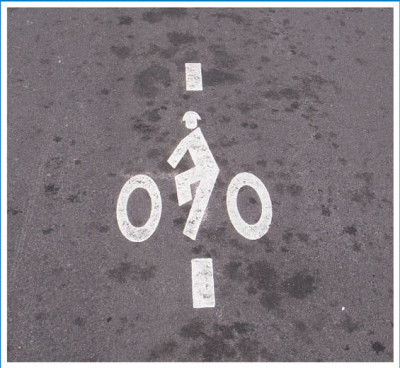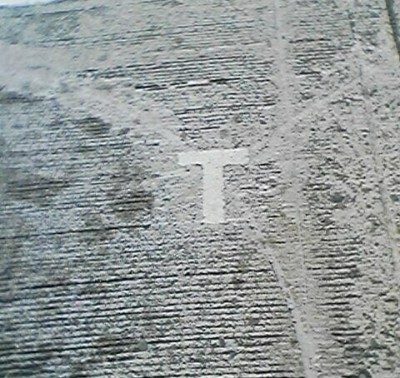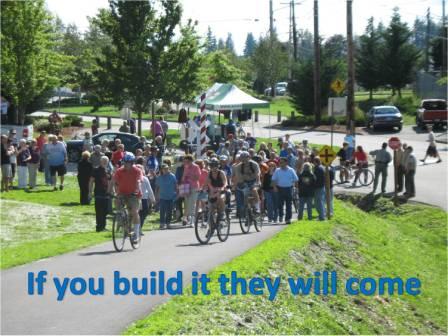 Trails hold a special place in our hearts as an organization. Over the years Washington Bikes has assisted a number of local trail groups in getting started and advancing projects. Some of the state’s trail groups started with WA Bikes as their financial home, providing donors with an established nonprofit fiscal administrator.
Trails hold a special place in our hearts as an organization. Over the years Washington Bikes has assisted a number of local trail groups in getting started and advancing projects. Some of the state’s trail groups started with WA Bikes as their financial home, providing donors with an established nonprofit fiscal administrator.
Washington trails hold a special place in America, too: #1 for rails-to-trails mileage.
Trails hold a place on our legislative agenda. Every two years when the state legislature adopts the biennial budget, we work for trail funding as part of our overall priority to increase investments in bicycle facilities.
Trails also hold a special place in the hearts of the people who make trail time a part of their everyday lives or a special destination.
At a Wenatchee meeting of the Governor’s Blue Ribbon Task Force on Parks and Outdoor Recreation in July 2014, Wenatchee Chamber of Commerce Executive Director Shiloh Schauer expressed the importance of trails when she said, “I didn’t grow up in a Wenatchee without the Apple Capital Loop Trail, and my (future) children won’t grow up in a Wenatchee that doesn’t have a Rocky Reach Trail.”
In 2014 many trail projects made progress, whether they were just getting started, adding mileage, or closing a significant gap. Each project leverages the existing trail mileage as they link into larger regional networks that become magnets to draw tourists as well as serve residents for transportation, health, and recreation.
- If we missed your trail project on this list, tell us and we’ll add it.
- As your trail project makes progress in 2015 drop us a note; we’d love to celebrate it for all to see.
- We’re listing local trail support groups or city/county departments you can contact if you’re interested in helping make the trail in your community even better.
Olympic Peninsula
Olympic Discovery Trail: In 2014 the Spruce Railroad Trail upgrade was completed, with work to extend it to the McFee Tunnel to follow in 2015. It took some advocacy work from Washington Bikes and Peninsula Trails Coalition to keep this project on track. The ODT represents a giant collaborative enterprise of jurisdictions from local to state to federal. The 138-mile trail provides an amazing car-free experience with views of mountains, forests, rivers, lakes, and ocean.
[Tweet “WA state has great trails! 2014 progress Olympic Discovery Trail #ODT @OlyDiscoTrail “]
Kitsap Peninsula
A major land acquisition helps preserve thousands of acres that will someday include mountain bike trails and a section of the future Sound to Olympics Trail. The Sound to Olympics Trail is part of the proposed “String of Pearls” Trail plan for Kitsap County that would connect with the Olympic Discovery Trail and the Seattle area trail network via ferry. Kitsap County is also planning a similar trail south from Poulsbo to regional trails planned by Mason and Pierce counties.
Snohomish County
Snohomish County Bikes: We featured Snohomish County bicycling in a special series in 2014, with day trips and tour suggestions that involve trails and other connections.
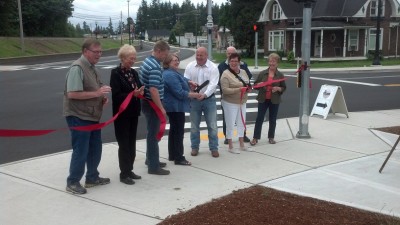
State Sen. Kurt Pearson (white shirt), Arlington Mayor Barbara Tolbert (blue blouse), Arlington City Council member Debora Nelson (tan blouse/sling), and others celebrate the opening of a new segment of the Snohomish Centennial Trail, June 7, 2014.
Snohomish County Centennial Trail: A missing link was completed as part of a street project in Arlington, with a ribbon-cutting held in June to celebrate. The 10-12-foot path features “Welcome to Arlington” banners and art tiles created by local artists.
Whitehorse Trail: Washington Bikes worked hard with Snohomish County Parks and Recreation and others to keep this project moving forward. It still faces challenges but its future development is a priority for growing bike tourism as part of the county’s economic recovery from the Oso landslide. The Whitehorse Trail runs from the Snohomish Centennial Trail through Oso to Darrington.
[Tweet “Can’t wait to ride Whitehorse Trail Arlington-Oso-Darrington. #bikesnoco”]
King County
Cross-Kirkland Corridor: A 5.75-mile segment of the 42-mile Eastside Rail Corridor, the Cross-Kirkland Corridor got under way in 2014 with a groundbreaking ceremony for construction of an interim crushed-gravel surface. Dec. 31, 2014, the Federal Surface Transportation board ruled against an effort to restore rail service in the corridor, keeping the trail project moving forward.
[Tweet “I’ll be biking the Cross-Kirkland Corridor. Thx @KirklandGov!”]
Eastside Rail Corridor: The Cross-Kirkland Corridor represents progress on this larger project, which will serve as a backbone connecting the region’s trails into a network.
When constructed as proposed by King County, the 20-mile Eastside Rail Corridor will link to:
- Burke-Gilman Trail / Sammamish River Trail (27 mi)
- East Lake Sammamish Trail (11 mi)
- Cedar River Trail (16 mi)
- Soos Creek Trail (4 mi)
- Snoqualmie Valley Trail (29 mi)
- Green River Trail (12 mi)
- Interurban Trail (14 mi)
- Snohomish County Centennial Trail (17 mi)
- (Future Whitehorse Trail)
[Tweet “Eastside Rail Corridor Trail ties into huge network–can’t wait!”]
Issaquah-Preston Trail Link to Preston-Snoqualmie Trail
Completing a critical missing link, the installation of a two-way protected bike lane along High Point Way between Issaquah and Preston makes it possible to ride on bike infrastructure from the Burke-Gilman Trail to Snoqualmie Falls, a 50-mile ride. This fills one of the gaps identified in the Mountains to Sound Greenway Trail system.
[Tweet “Glad to have progress on @MTSGreenway trail gaps. Beautiful riding!”]
South Puget Sound
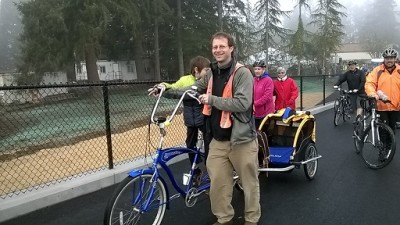
The Olympia-area community celebrated completion of the final phase of “Bridging the Gap” in the Chehalis-Western Trail Dec. 13, 2014.
Chehalis-Western Trail: Thurston County completed the final “bridging the gap” project with installation of the state’s first bike roundabout in Olympia.
Prairie Line Trail: Tacoma held a ribbon-cutting on a one-mile segment of this historic rail corridor through the University of Washington Tacoma campus. This segment is the middle leg of an urban trail that eventually will stretch from the Brewery District through the Museum District to the Thea Foss Waterway along the former Northern Pacific Railroad line.
Riverwalk Trail: Puyallup opened a quarter-mile stretch linking its 5-mile Riverwalk Trail to the 15-mile uninterrupted stretch of Pierce County’s scenic Foothills Trail, creating a a 20-mile-long trail from Puyallup to South Prairie.
Sumner Trail: After 20 years of effort the 5.5-mile Sumner Link Trail officially opened October 2014, linking to Puyallup’s Riverwalk Trail.
Foothills Trail: Pierce County Commissioners voted unanimously to move forward on property condemnations on a segment from South Prairie to Buckley needed for completion of the Foothills Trail.
[Tweet “Lots of progress 2014 for South Puget Sound trail links.”]
North Central Washington
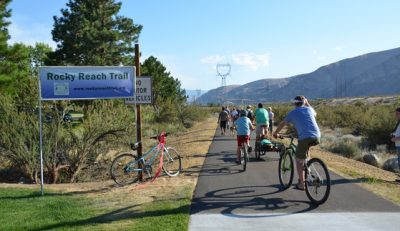 Rocky Reach Trail: This 5-mile addition to the Apple Capital Loop Trail along the east shore of the Columbia River in Douglas County connects Lincoln Rock State Park with the Apple Capital Loop Trail and the Wenatchee Valley riverfront parks.
Rocky Reach Trail: This 5-mile addition to the Apple Capital Loop Trail along the east shore of the Columbia River in Douglas County connects Lincoln Rock State Park with the Apple Capital Loop Trail and the Wenatchee Valley riverfront parks.
[Tweet “Rocky Reach Trail in Wenatchee=awesome! #bikeWEN”]
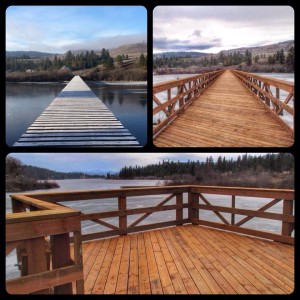
A redecked Ferry County Rail Trail
Ferry County Rail Trail: April 26, 2014, local advocates held a ribbon-cutting ceremony for the Curlew Lake trestle decking project. Ferry County received $70,000 from an RCO grant to gravel nearly 3 miles of the trail (projected completion by September 2015). Other RCO grants have been submitted for future work.
[Tweet “Ferry County Rail Trail made progress in 2014. Thanks WA state RCO!”]
Eastern Washington
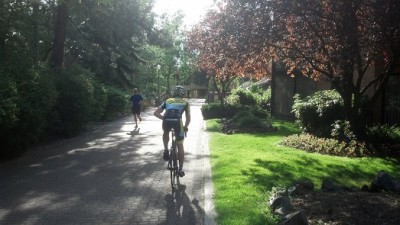 Spokane River Centennial Trail: Thanks to funding in the 2013 legislature for the Washington Wildlife and Recreation Program, which we supported along with partners such as the Washington Wildlife and Recreation Coalition, a 1.7-mile extension to the trail is under way that links to the Nine Mile Falls Recreation area on Long Lake (Lake Spokane). The trail also had reconstruction and riverbank restoration next to the Spokane Convention Center expansion.
Spokane River Centennial Trail: Thanks to funding in the 2013 legislature for the Washington Wildlife and Recreation Program, which we supported along with partners such as the Washington Wildlife and Recreation Coalition, a 1.7-mile extension to the trail is under way that links to the Nine Mile Falls Recreation area on Long Lake (Lake Spokane). The trail also had reconstruction and riverbank restoration next to the Spokane Convention Center expansion.
[Tweet “Spokane River Centennial Trail just keeps getting better. @WA_Cent_Trail #bikeSPO”]
Southeast Washington
Colfax-Pullman Rail Trail: Karl Boehmke is leading the charge with the Pullman Civic Trust to keep open the possibility of a future trail linking Colfax and Pullman. WA Bikes provided assistance to Karl when questions about the March 2014 US Supreme Court trail ruling came up. While the project has a long way to go, it represents great potential for growing bike tourism as part of the regional bike network that includes the Bill Chipman Trail linking Pullman to Moscow and the Latah Trail all the way to Troy, Idaho.
[Tweet “Hope to see @railstotrails grow in Pullman-Colfax area. #PalouseCountry”]
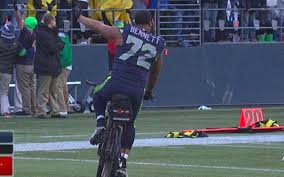
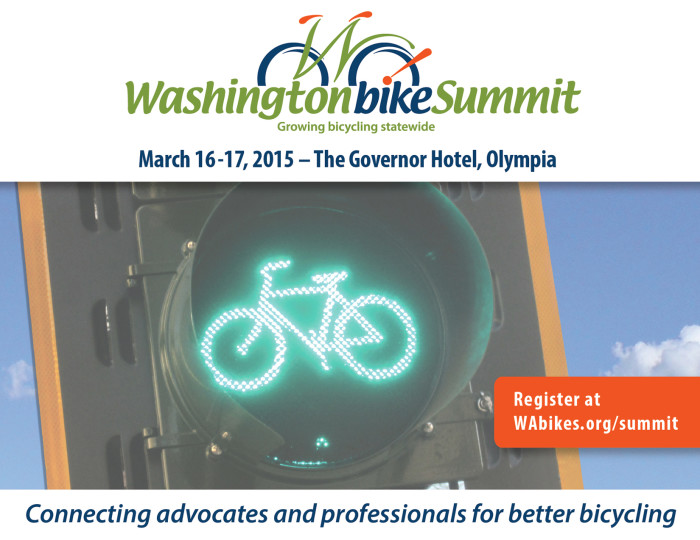 Registration is open for the
Registration is open for the 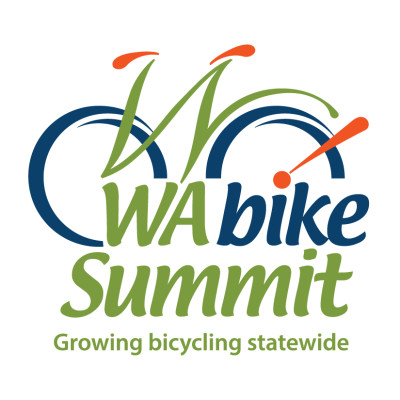 Years ago, what was then the Bicycle Alliance of Washington established the “Footprints and Bike Tracks” conference along with Bicycle Lobby Day. The lobby day evolved to become Transportation Advocacy Day, which each year brings 100-300 people to the capitol to tell legislators how important active transportation is for all of us whether we bike, walk, take transit, or drive. Somewhere along the way the conference stopped.
Years ago, what was then the Bicycle Alliance of Washington established the “Footprints and Bike Tracks” conference along with Bicycle Lobby Day. The lobby day evolved to become Transportation Advocacy Day, which each year brings 100-300 people to the capitol to tell legislators how important active transportation is for all of us whether we bike, walk, take transit, or drive. Somewhere along the way the conference stopped. 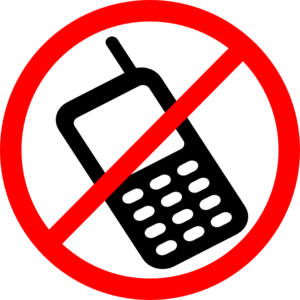
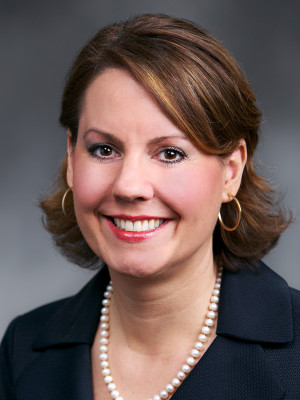
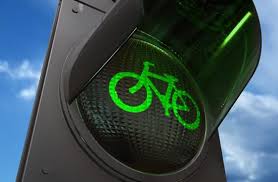 We’re not fans of the term “scofflaw” as applied to people on bicycles. It implies that riding a bike is associated with breaking the law more than people who drive. In fact,
We’re not fans of the term “scofflaw” as applied to people on bicycles. It implies that riding a bike is associated with breaking the law more than people who drive. In fact,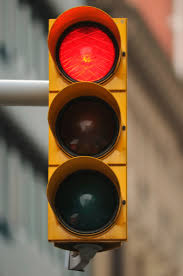 Traffic Signals and Bike Detection
Traffic Signals and Bike Detection


 Rocky Reach Trail: This 5-mile addition to the Apple Capital Loop Trail along the east shore of the Columbia River in Douglas County connects
Rocky Reach Trail: This 5-mile addition to the Apple Capital Loop Trail along the east shore of the Columbia River in Douglas County connects 
 Spokane River Centennial Trail: Thanks to funding in the 2013 legislature for the Washington Wildlife and Recreation Program, which we supported along with partners such as the Washington Wildlife and Recreation Coalition, a 1.7-mile extension to the trail is under way that links to the Nine Mile Falls Recreation area on Long Lake (Lake Spokane). The trail also had reconstruction and riverbank restoration next to the Spokane Convention Center expansion.
Spokane River Centennial Trail: Thanks to funding in the 2013 legislature for the Washington Wildlife and Recreation Program, which we supported along with partners such as the Washington Wildlife and Recreation Coalition, a 1.7-mile extension to the trail is under way that links to the Nine Mile Falls Recreation area on Long Lake (Lake Spokane). The trail also had reconstruction and riverbank restoration next to the Spokane Convention Center expansion.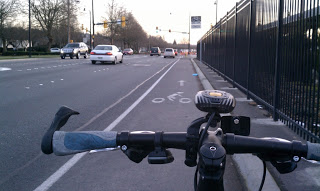
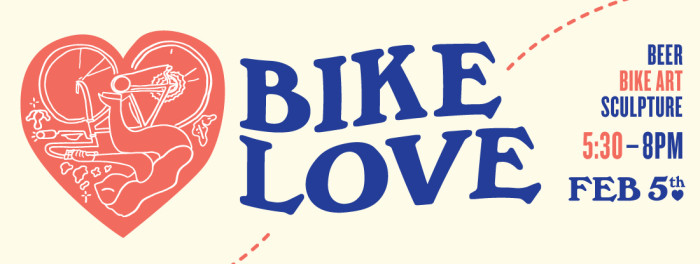
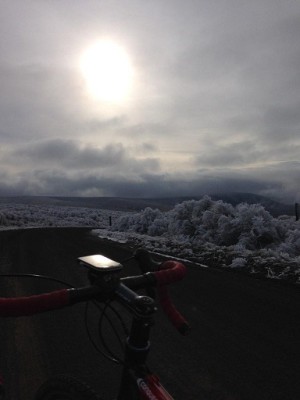 In a state with such enormous participation in
In a state with such enormous participation in 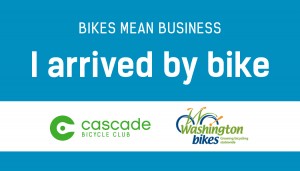 The cards, developed by
The cards, developed by 